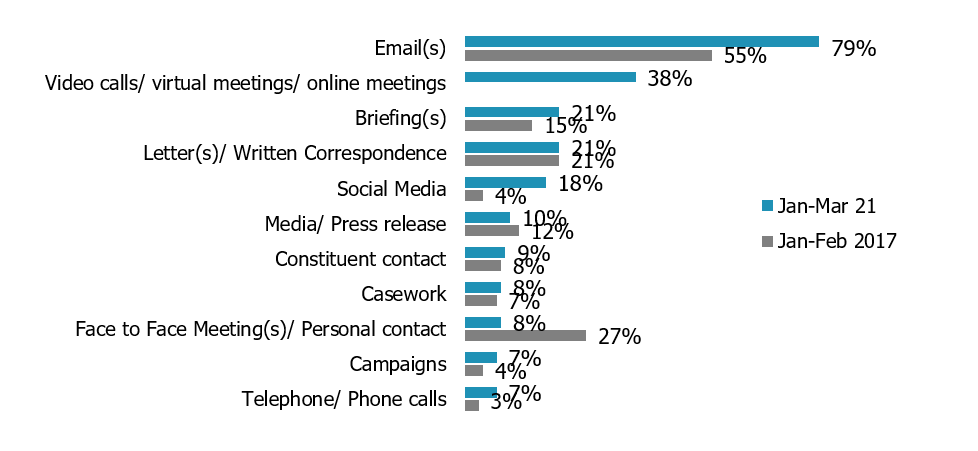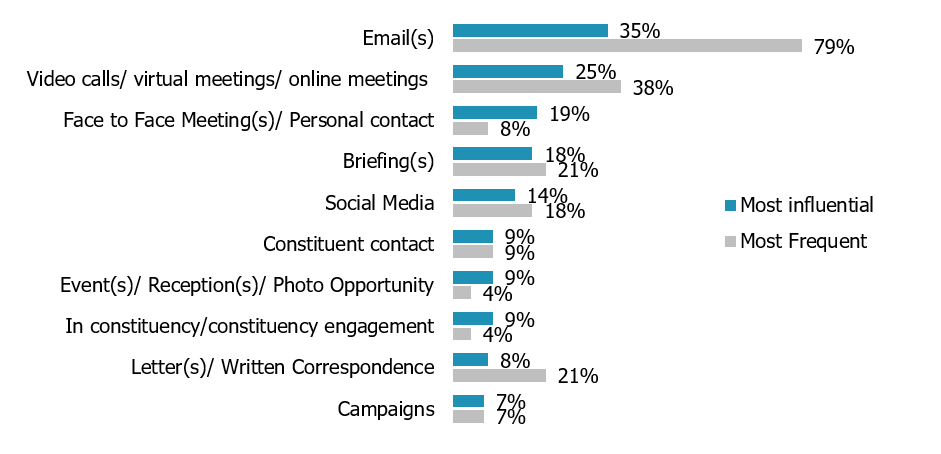The effect of the pandemic on the third sector has been both pervasive and extensive. Public affairs teams are just one of a number of departments that have had to adapt to a changing landscape brought on by Covid-19. Parliamentary office closures, social distancing, and the movement of parliamentary events, receptions, and face to face meetings to an online format has meant the traditional methods of communication with MPs has seen dramatic changes. At nfpSynergy we decided to investigate the changes that have occurred and how public affairs teams can adapt their engagement with MPs to suit the current climate.
In January - March 2021 we ran our quarterly wave of research with 100 representative MPs and asked them (unprompted) what the three most frequent and three most influential ways they came into contact with charities were.
Emails are the most frequent way to contact MPs
As chart 1 shows, emails continue to be, by far, the most frequent way MPs said they came into contact with charities. With the pandemic limiting the ways that charities can contact MPs, we have seen an increase to 79% of MPs saying it was the most frequent form of contact, compared with just over half (55%) in 2017.
Unsurprisingly the number of face-to-face meetings has decreased significantly with 27% of MPs listing it as a frequent form of contact in 2017 compared to just 8% in 2021. Whilst online and video call-based forms of contact has become the second most frequent form of contacting MPs.
Chart 1: Most frequent forms of contact over time
“What are the three most frequent ways you come into contact with charities, public bodies or government agencies in the last 12 months?” Unprompted question
Base: 100 MPs | Source: Charity Parliamentary Monitor, Jan - Mar 2021, nfpSynergy
Emails are also the most influential form of contact, whilst face-to-face meetings have declined in relevance
Emails were also the most influential way MPs said they were contacted as demonstrated by chart 2. A number of reasons were given for this with themes of convenience and ease often being mentioned. One returning Conservative MP saying “easiest way to get in touch and gives us the opportunity to reply quickly if we need further information". Whilst a returning SNP MP said “can read at home”, highlighting the importance of emails during a time when the pandemic was curtailing other forms of engagement. One Labour MP went further in highlighting the importance of emails saying it was the “only way possible in Covid”.
Also worth noting is the decline of face-to-face meetings as an influential form of contact shown in chart 2. In 2017 when we put this question to MPs, face-to-face meetings were considered the most influential way to be contacted listed by 41% of MPs. Face-to-face meetings are still recognised as an influential form of contact (19%), but the number of in-person meetings has gone down due to the limited opportunities to meet.
Chart 2: Most frequent and most influential ways that MPs were contacted
“What are the three most frequent ways you come into contact with charities, public bodies or government agencies in the last 12 months? What do you consider to be the three most influential ways you have come into contact with charities, public bodies or government agencies in the last 12 months?” Unprompted question, ranked by most influential
Base: 100 MPs | Source: Charity Parliamentary Monitor, Jan - Mar 2021, nfpSynergy
A quarter of MPs said video calls and virtual meetings were influential
As chart 2 shows, video calls and meetings were the second most influential way MPs were contacted. It was also one of the most frequent forms of contact, showing that charities have done a great job adapting their approach to the new reality. In contrast, no MPs mentioned video calls in 2017. It is encouraging to see that this shift to digital working has been embraced by MPs.
Video calls have opened up a new avenue for charities to contact MPs. Virtual meetings are often easier to organise, with no need to travel or book rooms, and consequently cheaper too. As one returning Conservative MP said, virtual meetings “allow quick updates without travelling”. Another returning Conservative MP commented similarly regarding zoom briefings, saying that they “allow me to make brief contact and keep up to date with their latest issue.”
There is no doubt that the movement towards virtual forms of contact has had a warm reception by MPs in some regards. But the important question is once in-person meetings can resume, how many MPs will still request video calls as their preferred method of communication?
Rishi Sunak has called on employers to allow staff back into the office, speaking of the benefits of in-person contact [1] and Conservative MPs have urged the PM to lift work from home guidance [2]. This may signal that some MPs will be swiftly back at Westminster and meeting in person as quickly as possible.
Whilst it is still uncertain when in-person meetings will become the norm again, it feels unlikely that virtual meetings have won over MPs to the extent that it will become the default form of contact. For some MPs they will continue to be happy to take video calls, which will save time and money for charities. Charities will need to consider how they adapt their approach. Will they be available for both types of meetings, or will they continue with the digital approach?
Social media has become a more influential form of engagement
A final point worth considering is that more MPs mentioned social media as an influential way they had been contacted by charities. 14% of MPs said social media was influential this year compared with only 5% in 2017. In particular social media seems to work well for engaging MPs with campaigns. One Labour MP commented on this saying it’s “easy for me to see campaigns and share” whilst another returning Labour MP said they can “see their campaigns online, can easily interact with them and promote.”
However, despite this increase, it is more of a lighter touch than the other influential forms of contact, where engagement could be as limited as liking or retweeting a post. One Returning Conservative MP also warned that it “can be quite hit and miss”.
Whilst many charities will be looking forward to getting back to normal methods of campaigning, whether through in-person contact with MPs, or organising on the streets, the salience of social media as a means of engaging MPs is unlikely to go away. For charities the question going forward is seemingly how to convert that online interaction into meaningful engagement.



